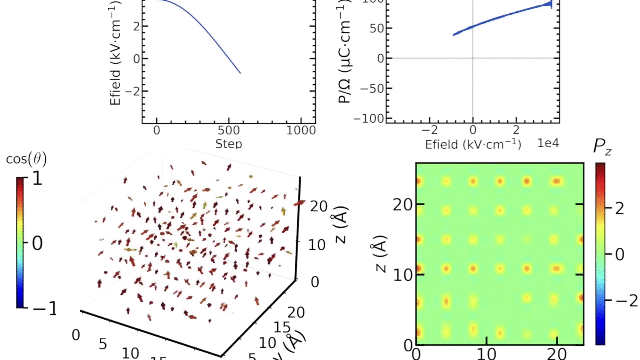News
Researchers in the Harvard John A. Paulson School of Engineering and Applied Sciences (SEAS) have developed a machine learning framework that can predict with quantum-level accuracy how materials respond to electric fields, up to the scale of a million atoms – vastly accelerating simulations beyond quantum mechanical methods, which can model only a few hundred atoms at a time.
The work will allow scientists and engineers to carry out highly accurate, large-scale simulations of different materials’ responses to many external stimuli, which could have major implications for advanced materials design or energy technologies.
The research was published in Nature Communications and led by Stefano Falletta, a former postdoctoral researcher in the group of senior author Boris Kozinsky, the Gordon McKay Professor of Materials Science and Mechanical Engineering at SEAS, and Professor of Chemistry and Chemical Biology.
For more than 30 years, the primary method for simulating the properties and behaviors of atoms and molecules has been density functional theory, a set of quantum-mechanical equations that is physics-based and highly accurate, but computationally intensive and thus limited to only smaller systems.
In recent years, studying quantum behavior of materials at larger sizes and longer time scales while retaining the accuracy of density functional theory has been bolstered by machine learning, but modeling responses to external stimuli has remained a challenge. This is because existing machine learning methods tend to overlook physical symmetries and conservation laws related to both energetic and electrical properties, leading to inaccuracies in property predictions.
To solve these issues, the authors devised a machine learning method that unifies distinct quantum behaviors like energy and polarization into one generalized potential energy function. Using density functional theory calculations as training and validation data, the model includes the effects of external fields and enforces the correct physics.
The new framework, called Allegro-pol, builds on a previously developed neural network architecture called Allegro that performed accurate simulations of the energy and atomic forces present in a given set of atoms. Falletta looked to extend the capabilities of Allegro to capture not only real-time molecular dynamics, but also, what happens when the atoms undergo external perturbations, such as the application of an external electric field. Understanding these interactions is essential for discovering, for example, new ferroelectric materials and dielectric materials that could be used in applications such as non-volatile memory, capacitors, and energy storage devices.
“If you use physics-based methods that solve quantum mechanical equations, you can only go up to a few hundred atoms,” said Falletta. “Whereas with these machine learning methods, you can essentially scale up to hundreds of thousands of atoms or even a million.”
They proved out their method by simulating infrared and electrical properties of silicon dioxide, as well as temperature-dependent ferroelectric switching in barium titanate.

Separations of electric poles in tetragonal barium titanate during transition from up to down polarization in the presence of an electric field.
Falletta, who now works at Radical AI on accelerating materials discovery, said that foundational models based on the one described in Nature Communications could allow machine learning-enabled materials science to take off in ways only beginning to be understood.
“The field of computational materials discovery is moving toward better theories, better machine learning models, better infrastructure, bigger clusters, faster GPUs, and better generative models – it’s all kind of coming together,” Falletta said. “It’s definitely very exciting.”
The paper was co-authored by Andrea Cepellotti, Anders Johansson, Chuin Wei Tan, Marc L. Descoteaux, Albert Musaelian, and Cameron J. Owen. The research was supported primarily by the National Science Foundation through the Harvard University Materials Research Science and Engineering Center Grant No. DMR-2011754; the U.S. Department of Energy, Office of Basic Energy Sciences Award No. ML-22-075; and the Department of Navy award N00014-20-1-2418 issued by the Office of Naval Research and Robert Bosch LLC.
Topics: AI / Machine Learning, Computational Science & Engineering, Data Sciences, Materials, Materials Science & Mechanical Engineering, Research
Cutting-edge science delivered direct to your inbox.
Join the Harvard SEAS mailing list.
Scientist Profiles
Boris Kozinsky
Gordon McKay Professor of Materials Science and Mechanical Engineering and Professor of Chemistry and Chemical Biology
Press Contact
Anne J. Manning | amanning@seas.harvard.edu



